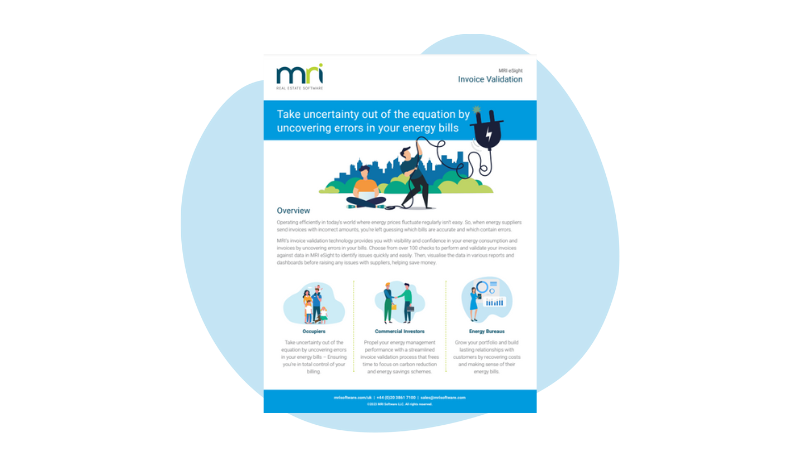The data you need to report on your energy saving targets
The correlation between data and energy saving targets
Reporting on your energy saving targets is a vital part of any effort to increase energy efficiency in your business. The process involves collecting and analysing large amounts of data to uncover actionable steps to decrease energy consumption.
But how do you cut through the noise to see the trends in your data?
Bridging the gap between data and understanding is a difficult task. Without a centralised dashboard detailing your commercial building’s energy consumption and associated costs, meeting energy saving targets, reducing energy usage and improving overall energy efficiency becomes complicated and difficult to navigate.
So, how do you leverage data to uncover insights and create accurate reports?
To tell your energy story, you need to collect the right data and organise it effectively. The key lies in utilising the right metrics to focus on the data that provides reporting value. By focusing and reporting on these metrics, you can make data-based decisions that help you meet energy saving targets.
1. Monitoring – collecting the right data
Good reporting relies on collecting real-time, reliable, and accurate data. Measurement of energy performance across a building is the backbone of any meaningful energy reduction strategy.
Smart metering and monitoring tools, for example, are essential for both measurement and efficient energy management. In a single office building, an effective metering and monitoring system can often generate an immediate energy saving of 10%, and up to 30% once building operations are enhanced over time.
Continuous automatic metering systems use dynamic energy dashboards to display building operation and energy consumption data. Tables, graphs and images are used to illustrate energy information in ways that facilitate informed decision-making.
For example, an energy dashboard may display that a building’s aeration system is consuming more energy than it should. Once informed of this fact, the operator can reduce energy consumption incrementally to reach energy saving targets without negatively impacting performance.
A Building Automation System (BAS) monitors the performance of equipment at a high-level and concerns the building as a whole. A BAS can automate controls for things like elevators, metering, air-handling units, heat pumps, lighting systems and more. A newer BAS can maximise the energy efficiency of all the things it controls, as well as monitor fire and flood safety. While a BAS does not generally offer advanced analytics, it can be leveraged in combination with Energy Management Software (EMS) to extract key data for reporting.
When it comes to collecting data over time, using 15-minute intervals strikes the right balance. As an energy manager, you want to reduce noise in the data to produce a clear picture of how your building and equipment within the building are operating. If you were to review data at 10, 5 or even 1-minute intervals, you would notice more scattering of the data, making it difficult to understand what is actually happening in the equipment.
With 15-minute intervals, energy usage patterns can become clearer and more easily interpreted, making reporting on energy saving targets more effective.

2. Organising the data – not all data points are created equal
When it comes to interpreting energy data, it’s important to understand and account for different types of data. Comparing total or average energy use in one sector against another will lead to skewed data.
For example, manufacturing plants often have long operating hours and heavy machinery which requires a lot of energy to cool. So, comparing it against a distribution centre based on total or average energy used will provide an uneven representation of total energy usage.
It’s imperative that data is normalised in order to interpret it correctly and for reporting on energy saving targets.
Take degree days for instance. Degree days are a measure of the severity and duration of cold weather. It’s a vital metric because extreme outdoor air temperature will require more energy to stabilise setpoint temperature in the building. Therefore, to avoid misleading statistics, you should also normalise against active hours and normalised occupancy. Once the data is normalised, you can look at it to determine the priority area of focus.
For example: an energy manager of a manufacturing plant notices that packaging has the highest energy consumption of all activities across the plant. That would highlight to the energy manager that improving the energy efficiency of packaging operations is a priority.
3. Reporting – get the bigger picture
Most organisations have data loggers and systems across their commercial buildings to capture energy usage, performance and consumption data but, instead of filtering the information and refining the most actionable parts, it is all compiled into a single large and very complex report.
Instead of a single large and complex report, those organisations could normalise their data and establish priority areas of focus to understand data trends, leverage the right metrics and make data-driven decisions.
For example, with this approach, an energy manager can compare packaging across all the business’ plants and clearly see which are more efficient than others. The manager can then review the efficient plants to determine best practices to improve energy consumption consistently across the enterprise in line with energy saving targets.
Efficient reporting is about compiling the clearest possible picture of your energy usage and costs to people at different levels of your business and relies heavily on the ways in which you collect and interpret energy data.
If you have multiple sites, comparing energy consumption increases in complexity as your organisation may be balancing a variety of business operations. Normalising energy data facilitates effective comparison to help you to clearly understand your energy consumption patterns and performance across separate business units.
When you’re able to obtain a high-level overview of energy consumption, using the right metrics turns that raw data into insight, giving you the ability to make data-driven decisions for your business and to take real and consistent steps towards your energy saving targets.
Take uncertainty out of the equation by uncovering errors in your energy bills
Operating efficiently in today’s world where energy prices fluctuate regularly isn’t easy. So, when energy suppliers send invoices with incorrect amounts, you’re left guessing which bills are accurate and which contain errors. Gain peace of mind and …
